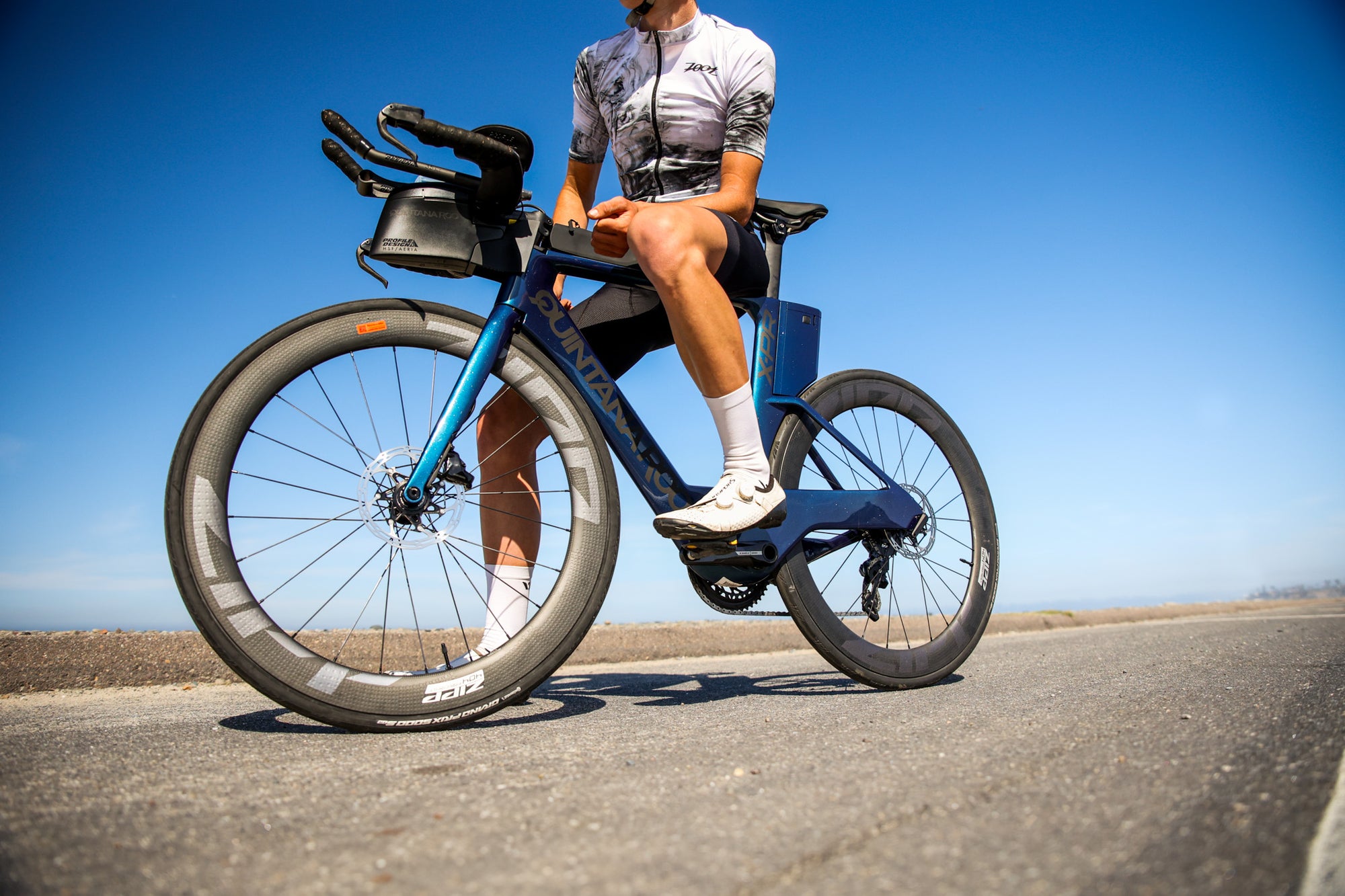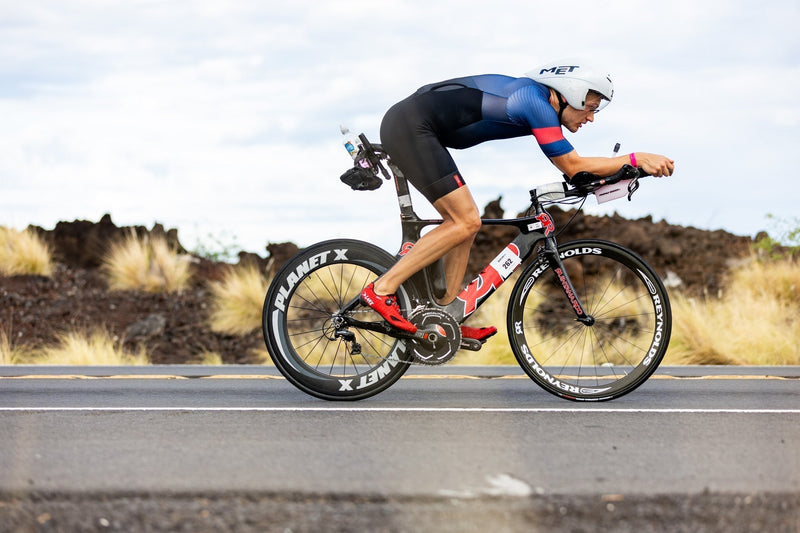TRIATHLON AND ROAD BIKE TIRE PRESSURE GUIDE

Many triathletes are willing to spend thousands of dollars optimizing their equipment just to shave seconds off their finish times. However, one bike component costs nothing but has one of the biggest impacts on your performance: the air in your tires!
Tire pressure is one of the most important factors you need to consider when setting up your triathlon or road bike. Choosing the right tire pressure will improve your performance, comfort, confidence, and safety. We’ll give you our recommended tire pressures for your bike and our top tire pressure tips to help get you rolling.
Quintana Roo Triathlon and Road Bike Recommended Tire Pressure Chart
Find your tire pressure based on rim type (hooked or hookless), rider weight, and tire width. All tire pressures are listed in PSI:
Recommend Tire Pressures for HOOKED Rims
|
23mm |
25mm |
28mm |
30mm |
32mm |
|
|
100 lbs |
70 |
65 |
60 |
55 |
50 |
|
110 lbs |
72 |
67 |
62 |
57 |
52 |
|
120 lbs |
74 |
69 |
64 |
59 |
54 |
|
130 lbs |
76 |
71 |
66 |
61 |
56 |
|
140 lbs |
78 |
73 |
68 |
63 |
58 |
|
150 lbs |
80 |
75 |
70 |
65 |
60 |
|
160 lbs |
82 |
77 |
72 |
67 |
62 |
|
170 lbs |
84 |
79 |
74 |
69 |
64 |
|
180 lbs |
86 |
81 |
76 |
71 |
66 |
|
190 lbs |
88 |
83 |
78 |
73 |
68 |
|
200 lbs |
90 |
85 |
80 |
75 |
70 |
|
210 lbs |
92 |
87 |
82 |
77 |
72 |
|
220 lbs |
94 |
89 |
84 |
79 |
74 |
|
230 lbs |
96 |
91 |
86 |
81 |
76 |
|
240 lbs |
98 |
93 |
88 |
83 |
78 |
|
250 lbs |
100 |
95 |
90 |
85 |
80 |
Recommend Tire Pressures for HOOKLESS Rims
See the section below for more information on hookless rims and tire pressures. For hookless rims, we generally recommend using lower pressures and suggest avoiding certain rider weight/tire width combinations for more safety.
|
23mm |
25mm |
28mm |
30mm |
32mm |
|
|
100 lbs |
60 |
55 |
50 |
45 |
40 |
|
110 lbs |
62 |
57 |
52 |
47 |
42 |
|
120 lbs |
64 |
59 |
54 |
49 |
44 |
|
130 lbs |
66 |
61 |
56 |
51 |
46 |
|
140 lbs |
68 |
63 |
58 |
53 |
48 |
|
150 lbs |
70 |
65 |
60 |
55 |
50 |
|
160 lbs |
72 |
67 |
62 |
57 |
52 |
|
170 lbs |
- |
69 |
64 |
59 |
54 |
|
180 lbs |
- |
71 |
66 |
61 |
56 |
|
190 lbs |
- |
- |
68 |
63 |
58 |
|
200 lbs |
- |
- |
70 |
65 |
60 |
|
210 lbs |
- |
- |
72 |
67 |
62 |
|
220 lbs |
- |
- |
- |
69 |
64 |
|
230 lbs |
- |
- |
- |
71 |
66 |
|
240 lbs |
- |
- |
- |
- |
68 |
|
250 lbs |
- |
- |
- |
- |
70 |
Triathlon and Road Bike Tire Pressure: 5 Key Tips

1. DO NOT exceed the maximum tire pressure of your rims
This is the most important thing to know when inflating your tires.
Exceeding the maximum tire pressure approved by the rim manufacturer can cause your rim or tire to fail, resulting in a crash or injury. Maximum tire pressure can often be found on a sticker on the rim or on the wheel manufacturer’s website.
General recommendations:
- Hooked tubeless rim max: 100 PSI / 6.9 BAR
- Hookless tubeless rims max: 72.5 PSI / 5 BAR
It’s important to know whether your rims are hooked or hookless. Tires on hookless rims should never be should never be inflated beyond 72.5 PSI. Exceeding this can cause tires to fail.
Currently, all standard and upgraded wheel options offered by Quintana Roo are tubeless. Wheels from DT Swiss and HED are generally hooked. Wheels from Zipp and ENVE are generally hookless. If you need clarification on whether your wheels are hooked or hookless consult the wheel manufacturer or our Customer Service team.
2. DO NOT pump your tire up to the pressure printed on the tire
To maximize your safety and ride experience, refer to the recommended tire pressure chart below.
Many tires have a tire pressure printed on the sidewall of the tire. This is a maximum tire pressure NOT a recommended riding pressure. The maximum tire pressure printed on the tire can exceed the maximum tire pressure of the rim. Inflating your tires this high will also result in a very poor riding experience.
3. DO use a tire pressure gauge
A tire pressure gauge is for dialing in your tire pressure. Fortunately, many modern bike pumps will come with a built-in gauge, or you can use an affordable handheld gauge.
Keep in mind that tire pressure gauges are not always accurate. Digital tire pressure gauges tend to be more accurate than analog gauges. Consistency is the most important thing, so it is best to always use the same gauge so you have a consistent baseline to make tire pressure comparisons and changes.
4. DO inflate your tires up before every ride
Tires will lose air throughout the day, and tubeless tires can lose air slightly faster than traditional tires with butyl tubes. To ensure consistent performance, it’s best to inflate your tires to your desired pressure before every ride.
5. DO experiment with your tire pressures
Recommended tire pressures are just that—recommendations. It’s a good idea to experiment with higher or lower pressures to find the best fit for your terrain, riding preferences, and needs. We’ll dive into how to experiment to find your ideal tire pressure below.
How To Dial In Your Tire Pressure

The tire pressures in the above chart are recommended starting points. Most riders will need to adjust tire pressures to suit their local terrain and riding preferences. As you experiment with your tire pressure, you may find that you prefer using tire pressures 5-15 PSI higher or lower than what’s recommended!
When experimenting with tire pressures, it’s often best to test changes in 2-3 PSI increments. The ideal tire pressure strikes a good balance between comfort (lower pressures are more comfortable) and puncture protection (higher pressures reduce punctures).
Here are a few basic tips:
Increase Your Tire Pressure If:
- Your bike bounces when pedaling or accelerating.
- Your tires squirm, fold, or lack support while braking or cornering.
- Your tires bottom out on the rim when hitting bumps, cracks, or potholes. Rim strikes can cause rim damage and punctures.
Decrease Your Tire Pressure If:
- Your bike transmits excessive vibration from the road into your hands, feet, and sit bones.
- Your bike feels like it lacks traction while braking or cornering.
- Your bike feels excessively harsh when hitting bumps, cracks, or potholes.
Additional Tips
- The ideal tire pressure can also vary depending on the tire and wheel:
- High-performance tires with thinner, and more supple casings typically need more pressure than mid-range tires with thicker or puncture-resistant casings.
- A rim with a narrower internal width typically needs more pressure than a rim with a wider internal width, due to widener rims providing more air volume.
- Some riders may prefer using 1-2 PSI less in the front tire to increase front-end comfort or traction.
Bike Tire Pressure FAQ
Aren’t higher tire pressures faster and lower tire pressures slower?
This is only true on perfectly smooth riding surfaces (e.g. a velodrome). Roads are rarely perfectly smooth. They have bumps, cracks, potholes, chipseal, and other imperfections.
Many riders think higher tire pressures feel faster because firmer tires transmit more vibration, bumps, and shocks. This creates the illusion that you’re going faster. Vibration, bumps, and shocks, however, are all forms of wasted energy.
Getting bounced around isn’t fast! Smooth is fast. Lower pressures allow your tires to conform to the road surface, reducing rolling resistance and allowing more of your energy to propel you forward. They also increase comfort, which can improve your performance in endurance events.
What if I am above or below the weight range of the tire pressure chart?
If you are outside the weight range presented on this chart, try the pressure listed at the top/bottom of the chart first and adjust from there. DO NOT exceed the maximum pressure of the wheel/rim.
I have hookless wheels and the tire pressure chart recommends using more than 72.5 PSI
If you have hookless wheels, but the pressure recommended by the chart above is higher than 72.5 PSI, we suggest the following solutions:
- Inflate your tires to 72.5 PSI or lower - the above chart only provides recommended pressures. There is a chance your bike will ride great at or below the recommended tire pressures listed in the chart. The only way to know is to try it.
- Switch to a wider tire - wider tires have more air volume and will allow you to use lower tire pressures.
- Switch to hooked rims - If you are unable to fit a wider tire or don’t feel comfortable running 72.5 PSI or less, you will need hooked rims to achieve your desired tire pressures.
What if I want to run above 100 PSI / 6.9 BAR?
Inflating your tires above 100 PSI is NOT RECOMMENDED for modern tubeless tires or wheels. If you want to inflate your tires above 100 PSI, we recommend using tube-type tires and wheels.



